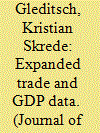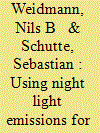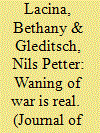| Srl | Item |
| 1 |
ID:
065789


|
|
|
| 2 |
ID:
152294


|
|
|
|
|
| Summary/Abstract |
Nighttime illumination can serve as a proxy for economic variables in particular in developing countries, where data are often not available or of poor quality. Existing research has demonstrated this for coarse levels of analytical resolution, such as countries, administrative units or large grid cells. In this article, we conduct the first fine-grained analysis of night lights and wealth in developing countries. The use of large-scale, geo-referenced data from the Demographic and Health Surveys allows us to cover 39 less developed, mostly non-democratic countries with a total sample of more than 34,000 observations at the level of villages or neighborhoods. We show that light emissions are highly accurate predictors of economic wealth estimates even with simple statistical models, both when predicting new locations in a known country and when generating predictions for previously unobserved countries.
|
|
|
|
|
|
|
|
|
|
|
|
|
|
|
|
| 3 |
ID:
125145


|
|
|
|
|
| Publication |
2013.
|
| Summary/Abstract |
A number of recent studies argue that there is decline in armed conflict within and between nations. Gohdes and Price run against the grain in arguing that there is no evidence for a decrease in battle deaths in armed conflicts after World War II and that the trend reported in our earlier articles is spurious. However, they do not plausibly justify this thesis. We reexamine the argument for a decline, exploring nonlinearities in the data and potential biases due to measurement error. We find that very strong assumptions must hold in order for measurement errors to explain the trend in battle deaths.
|
|
|
|
|
|
|
|
|
|
|
|
|
|
|
|